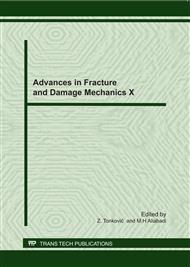[1]
P.W. Parfomak, P. Folger, Carbon Dioxide (CO2) Pipelines for Carbon Sequestration, Emerging Policy Issues, Congressional Research Service Report for Congress, 19 April 2007, Order Code RL33971.
Google Scholar
[2]
Det Norske Veritas, Recommended Practice DNV-RP-J202, Design and Operation of CO2 Pipelines, April (2010).
Google Scholar
[3]
S. Holloway, Carbon dioxide capture and geological storage, Philos Transact Royal Soc A Math Phys Eng Sci, 2007, 365: 1095–1107.
Google Scholar
[4]
H. Makino, T. Kubo, T. Shiwaku, et al., Prediction for Crack Propagation and Arrest of Shear Fracture in Ultra-high Pressure Natural Gas Pipelines, ISIJ Int, 2001; 41(4): 381–388.
DOI: 10.2355/isijinternational.41.381
Google Scholar
[5]
J.E. Hood, Fracture of Steel Pipelines, Int J Pressure Vessels Piping, 1974; 2: 165-178.
DOI: 10.1016/0308-0161(74)90001-5
Google Scholar
[6]
W. A Maxey, Factors Affecting Ductile Fracture in Offshore Gas Pipelines, Proceedings of the Offshore Technology Conference, OTC4241, 14th Annual OTC, May 1982, Houston, USA.
DOI: 10.4043/4241-ms
Google Scholar
[7]
G.D. Fearnehough, G.M. Lees, J.M. Lowes, R.T. Weitner, The Role of Stable Ductile Crack Growth in the Failure of Structures, Practical Application of Mechanics to Pressure Vessel Technology, Institution of Mechanical Engineers, (1970).
Google Scholar
[8]
F.M. Burdekin, J.F. Knott, J.D.G. Sumpter, A.H. Sherry, TAGSI views on aspects of crack arrest philosophies for pressure vessels with thicknesses up to 100mm, Int J Pressure Vessels Piping, 1999; 76: 879–883.
DOI: 10.1016/s0308-0161(99)00066-6
Google Scholar
[9]
G.D. Fearnehough, Fracture Propagation Control in Gas Pipelines: A Survey of Relevant Studies, Int J Pressure Vessel Piping, 1974; 2: 257-282.
DOI: 10.1016/0308-0161(74)90007-6
Google Scholar
[10]
S. Cravero, C. Ruggieri, Structural integrity of axially cracked pipeline using conventional and constrain-modified failure assessment diagrams, Int J Pressure Vessels Piping, 2006; 83: 607–617.
DOI: 10.1016/j.ijpvp.2006.04.004
Google Scholar
[11]
F.M. Burdkin, The Practical Application of Fracture Tests to Prevent Service Failures, Welding Research Supplement, March 1968, pp.129-139.
Google Scholar
[12]
H. Mahgerefteh, O. Atti, Modeling Low-Temperature-Induced Failure of Pressurized Pipelines, AIChE J, 2006; 52(3): 1248– 1256.
DOI: 10.1002/aic.10719
Google Scholar
[13]
F. Eldevik F, B. Graver, L.E. Torbergsen, O.T. Saugerud, Development of a Guideline for Safe, Reliable and Cost Effective Transmission of CO2 in Pipelines, Energy Procedia, 2009; 1: 1579–1585.
DOI: 10.1016/j.egypro.2009.01.207
Google Scholar
[14]
F. Eldevik, Safe Pipeline Transmission of CO2, Pipeline Gas J, 2008; 235(11): 76–77.
Google Scholar
[15]
Information on http: /www. transcanada. com/customerexpress/update/march_2004/ article_4. html.
Google Scholar
[16]
Recommended Practice for Conducting Drop-Weight Tear Test on Line Pipe, API RP 5L3, American Petroleum Institute Standard.
Google Scholar
[17]
Metallic materials – Drop weight tear test, BS EN 10274: 1999, British Standard.
Google Scholar
[18]
Standard Test Method for Drop-Weight Tear Test of Ferritic Steels, ASTM E436-91, ASTM International Standard.
DOI: 10.1520/stp18402s
Google Scholar
[19]
Standard Test Methods for Notched Bar Impact Testing of Metallic Materials, ASTM E23-07a, ASTM International Standard.
Google Scholar
[20]
J.C. Radon, C.E. Turner, Fracture Toughness Measurement by Instrumented Impact Test, Eng Fract Mech, 1969; 1: 411–428.
DOI: 10.1016/0013-7944(69)90002-2
Google Scholar
[21]
Critical Examination of Correlations between Fracture Toughness and Charpy Impact Energy, Offshore Technology Report – OTO 96 710, Health and Safety Executive.
Google Scholar
[22]
C.S. Weisner, Predicting Structural Crack Arrest Behaviour using Small-scale Material Characterisation Test, Int J Pressure Vessels Piping, 1996; 69: 185-196.
DOI: 10.1016/0308-0161(95)00131-x
Google Scholar
[23]
I. Gray, A.H. Priest, The Arrest of Propagating Cracks, Practical Applications of Fracture Mechanics to Pressure Vessel Technology, Institution of Mechanical Engineers, (1971).
Google Scholar
[24]
T.S. Robertson, Propagation of Brittle Fracture in Steel, J Iron Steel Inst, 1953; 175: 361–374.
Google Scholar
[25]
J.B. Ju, J.S. Lee, J.I. Jang, Fracture toughness anisotropy in a API steel line-pipe, Mater Lett, 2007; 61: 5178–5180.
DOI: 10.1016/j.matlet.2007.04.007
Google Scholar
[26]
A. Chahardehi, F.P. Brennan, A. Steuwer, The Effect of Residual Stresses Arising from Laser Shock Peening on Fatigue Crack Growth, Eng Fract Mech, 2010; 77(11): 2033–(2039).
DOI: 10.1016/j.engfracmech.2010.03.033
Google Scholar


